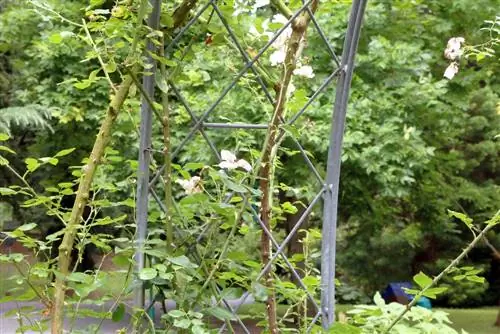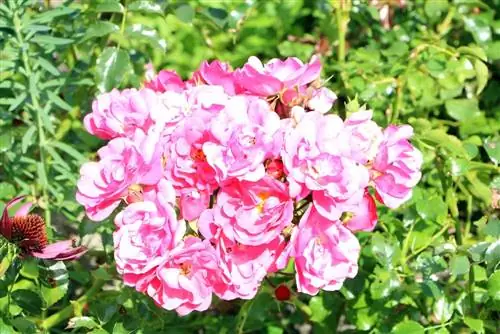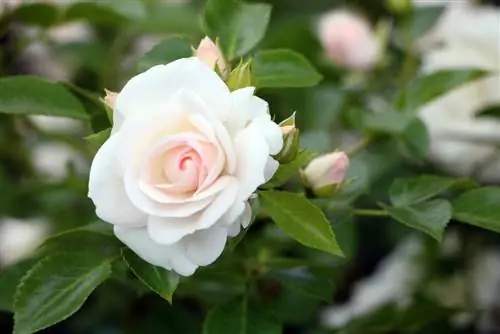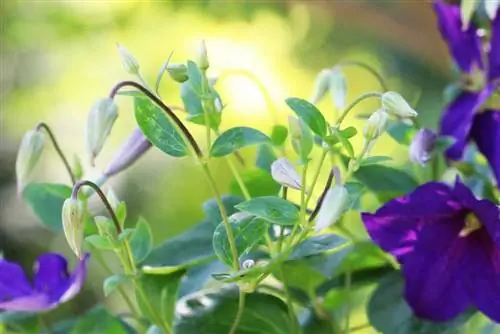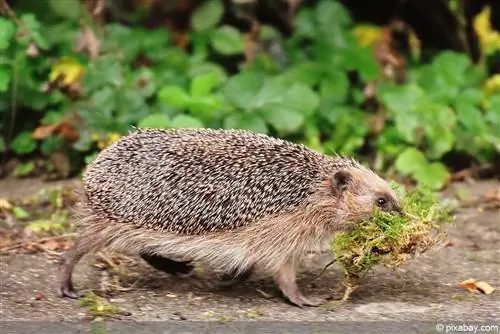- Author admin [email protected].
- Public 2023-12-17 03:39.
- Last modified 2025-01-24 12:45.
With floral opulence, climbing roses give facades, trellises and obelisks a breathtaking appearance. In order for the queen of flowers to achieve this masterpiece from the pot, a few specific premises must be taken into account. The following instructions aim to remove potential stumbling blocks for interested hobby gardeners when cultivating climbing roses in planters. The following lines get to the heart of how to plant climbing roses in pots, care for them properly and make them winter-proof.
The ideal bucket
As deep-rooted roses anchor themselves deep in the soil. Once established at the site, the taproots reach up to 100 centimeters deep into the ground. This property implies that only a large pot can offer sufficient space for the root ball of climbing roses. This is what the perfect planter should be like:
- At least 40 centimeters high
- Ideally tapering downwards
- One or more floor openings as a water drain
- Of light color to reflect sun rays
As climbing roses develop considerable weight over time, plastic planters are ruled out from the outset. Choose a frost-proof, stable material that guarantees stability. Since roses value keeping their feet cool, pots made of zinc or another metal are out of the question. Such materials heat up too much when exposed to summer sunlight.
Plants
A central criterion for the successful cultivation of climbing roses in pots is the choice of substrate. While the roses thrive excellently in clay soil in the garden, this only applies to a limited extent in the planter. The focus here is on the permeable, airy quality so that there is no waterlogging. Consider using high-quality rose soil from specialist retailers or your own mix that consists of a maximum of 50 percent clay, optimized with additives such as compost, sand, peat, perlite, coconut fibers, polystyrene beads and similar materials. How to plant step by step:
- Place the still potted climbing rose with the root ball in water until no more air bubbles appear
- Cover the water drain with a 3-5 cm high drainage made of grit, expanded clay, pebbles or pottery shards
- Spread an air- and water-permeable fleece over it so that the material is not clogged with soil crumbs
- Pour in a first layer of substrate, unpot the rose, plant it in the middle and water it
- The grafting point should ultimately be about 5 cm deep in the ground
Cautious hobby gardeners consider a watering edge to prevent water from spilling over.
Tip:
If climbing roses in the pot are placed on a plant roller from the start, this measure creates flexible mobility even as the weight increases.
Trellis and tying up
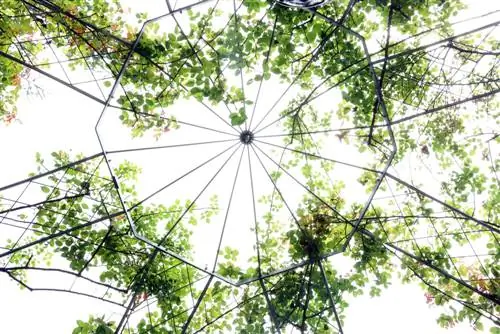
Climbing roses have no adhesive organs, so they cannot climb up independently. A climbing aid is therefore required to attach the long rose shoots to it. Cultivated in a pot, creative hobby gardeners have a wide range of possible climbing aids. The following overview may serve as inspiration on the way to finding an individual solution for your green kingdom:
- Column, a pyramid or an obelisk integrated into the bucket
- Placed in front of a house wall with a framework made of wood or tension wire
- Placed in front of a pergola or arbor
- Positioned at the base of a rose arch
Specialist retailers have plenty of suitable fastening material available. Binding material that does not cut into the plant tissue and is almost invisible thanks to the green color on the tendrils is ideal. When it comes to tying it up, the top directive is to arrange the climbing rose in an airy manner to prevent fungal infections. In addition, the horizontal guidance of the side shoots promises a particularly lush abundance of flowers.
Care
Climbing roses prefer a sunny and airy location. As much as the noble flowers would like to catch every ray of sunshine, they do not want to be exposed to the accumulated heat in front of a south wall protected from the wind. In general, roses appreciate care that is based on balance. This particularly applies to water and nutrient supply:
- Keep the substrate constantly slightly moist
- Even short-term waterlogging has fatal consequences
- Let the potting soil dry between waterings
- Administer organic liquid fertilizer from April to mid-July
The nutrient supply for climbing roses in the pot is only provided with organic preparations. The risk of over-fertilization is too great if mineral blue seed or rose fertilizer is used. Long-term fertilizers in stick or cone form are a realistic option because they only release their active ingredients gradually, so an overdose cannot occur.
Cutting
Regular pruning is a mainstay in the proper care of climbing roses. This measure regulates the growth of the long shoots so that they grow compactly and with lots of flowers. The ideal date for cutting is in late winter, shortly before new growth. How to do it right:
- Cut all dead wood and stunted branches at the base
- Cut off frozen shoot tips or those damaged by hail
- Short tendrils growing out of shape and pointing inwards
- Consistently cut out parts of plants affected by diseases or pests
- Do not cut annual rose branches, but rather tie them to the climbing aid
- Cut back older tendrils if necessary down to 3-4 eyes
Always place the rose scissors at a slight angle, just above a leaf node. These sleeping eyes are easy to identify as small bumps on the bark. After the main pruning takes place in late winter, summer pruning care is limited to regularly cleaning out withered flowers and withered leaves. However, if the decorative rose hips are desired, spent umbels are not removed. Every wild shoot, no matter how similar, that protrudes from the base is immediately torn off.
Tip:
If there are doubts about choosing the perfect time for pruning, the beginning of the forsythia flower gives the decisive signal.
Winterize
Regardless of the natural winter hardiness of roses, climbing species and varieties in pots require some protective measures. Choosing a large container helps protect against frostbite, as the root area freezes over much more slowly. Pay particular attention to the following aspects so that roses are prepared for the cold season:
- Stop fertilizing from mid-July so that the shoots mature
- Ideally place the bucket in front of a protective house wall
- Cover the container with bubble wrap, jute or coconut mats
- Hill the roots with leaf mold or cover with straw
Reed mats - placed in front of the trellis - keep frosty wind and piercing winter sun away from the rose vines. If possible, hang pine branches in the climbing aids or burlap.
Tip:
Laying the pot with bubble wrap before planting climbing roses creates effective protection against winter frost.
Watering in cold frost
In addition to adequate winter protection, an adequate water supply plays a central role. As experience shows, climbing roses in containers are more often threatened by drought stress during the cold season than during the summer. The cause is a special weather condition called cold frost. If frosty temperatures prevail and there is no snow, no water reaches the rose roots in the frozen substrate. Therefore, water on a frost-free day, but never with warm water.
Conclusion
Climbing roses reach breathtaking dimensions even in pots when they cover their climbing aids with dense carpets of flowers. In order for the queen of flowers to develop her floral splendor to perfection, various premises must be taken into account. Choosing a sufficiently large planter is important. Trailing roses are planted in a particularly airy and structurally stable substrate. The water and nutrient supply requires particular sensitivity because balance is required here. A central aspect of care is professional pruning, which should not be missed every year. If you also pay special attention to careful winter protection, the climbing roses will give their best for many years.

